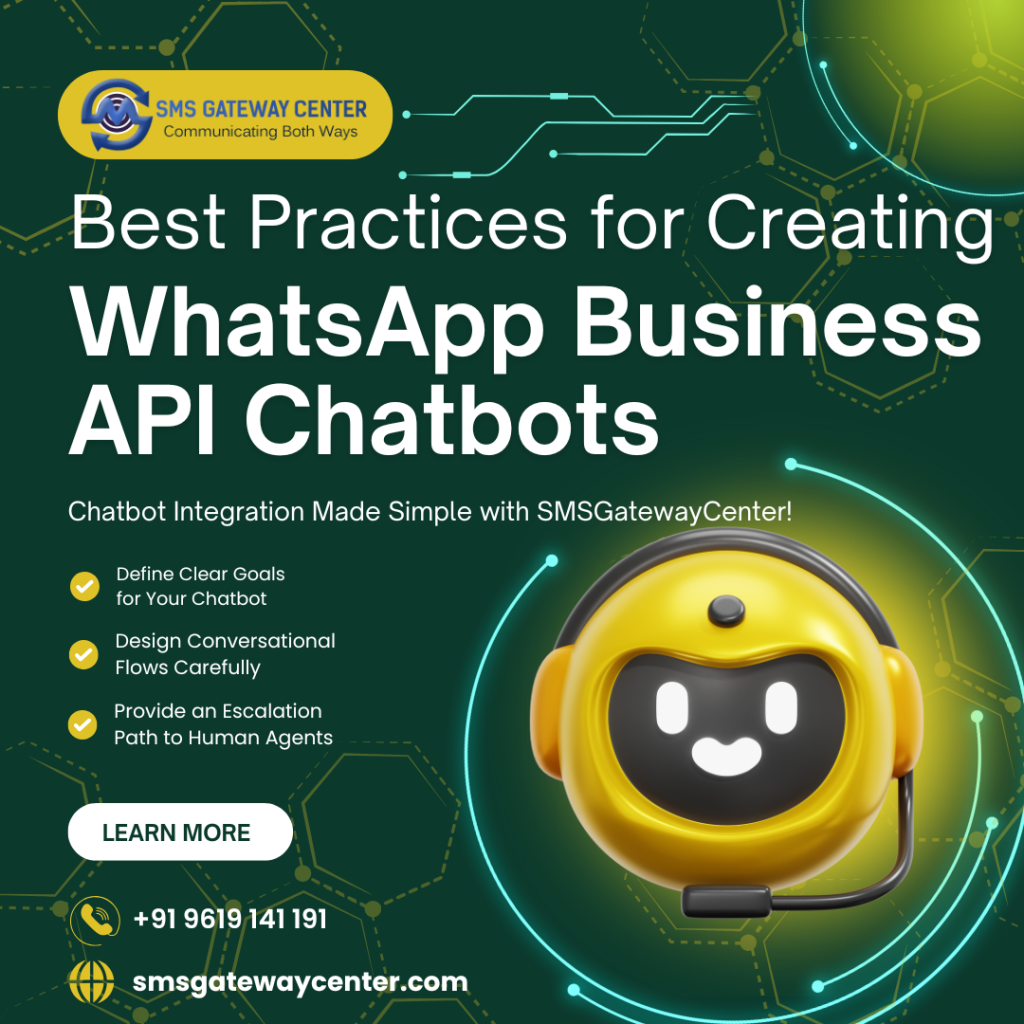Best Practices for Creating WhatsApp Business API Chatbots
Chatbots are revolutionizing customer service by providing instant, automated responses. WhatsApp Business API offers businesses the perfect platform to integrate powerful chatbots that streamline communication, enhance customer satisfaction, and drive business growth. Designing effective chatbots requires careful planning, technical expertise, and adherence to best practices to ensure seamless operations.

This guide explores the best practices for creating WhatsApp Business API chatbots, helping businesses maximize their potential.
1. Define Clear Goals for Your Chatbot
The Foundation of an Effective Chatbot
Before diving into development, identify the purpose and objectives of your chatbot. Answer questions like:
- What problems will it solve?
- Which customer needs will it address?
- Will it focus on customer support, lead generation, or order tracking?
Best Practices:
- Start with one or two key functions and expand gradually.
- Align chatbot goals with your overall business objectives.
- Use customer feedback to determine the most requested features.
2. Design Conversational Flows Carefully
Balancing Automation and Human-Like Interaction
An effective chatbot provides a seamless, intuitive experience. Poorly designed conversational flows can confuse users and lead to frustration.
Best Practices:
- Use Decision Trees: Map out possible customer inputs and responses to guide the conversation effectively.
- Add Fallback Options: Prepare responses for unexpected inputs and provide a way to escalate to a human agent.
- Personalize Messages: Use the customer’s name and context-specific responses to make interactions feel human.
Example:
If a user asks, “Where is my order?”, the bot should respond with specific details like:
“Your order was shipped on [date] and is expected to arrive by [date].”
3. Leverage WhatsApp-Specific Features
Unlocking the Full Potential of WhatsApp Business API
WhatsApp offers unique features that enhance chatbot functionality and user engagement.
Best Practices:
- Use Message Templates: Ensure compliance by using pre-approved templates for notifications and updates.
- Interactive Messages: Include buttons for quick replies or call-to-action options to simplify user navigation.
- Media Integration: Share images, videos, or PDFs for richer communication. For instance, send product catalogs or invoices directly via WhatsApp.
4. Prioritize Data Privacy and Security
Building Trust with Your Customers
WhatsApp Business API requires businesses to comply with data privacy regulations like GDPR and ensure secure communication.
Best Practices:
- Encrypt All Data: WhatsApp uses end-to-end encryption, but ensure your systems maintain the same standard.
- Obtain Consent: Always get explicit consent before sending messages or storing customer information.
- Mask Sensitive Data: Hide sensitive information such as account numbers during chatbot interactions.
By prioritizing security, you not only comply with regulations but also gain customer trust.
5. Train the Chatbot with AI and Machine Learning
Continuous Improvement for Better Conversations
A chatbot powered by AI can understand customer intent more accurately and adapt over time.
Best Practices:
- Use Natural Language Processing (NLP): Enable the chatbot to understand and respond to varied customer inputs.
- Incorporate Feedback Loops: Use customer interactions to refine responses and improve accuracy.
- Analyze Chat Logs: Identify patterns in customer queries and enhance the bot’s training dataset.
6. Integrate Seamlessly with Existing Systems
Ensuring a Unified Customer Experience
An effective WhatsApp chatbot should integrate with your CRM, ERP, and other business tools for end-to-end automation.
Best Practices:
- Sync Customer Data: Fetch and update user information from your CRM during interactions.
- Automate Tasks: Enable the bot to handle common workflows like processing refunds or scheduling appointments.
- Use Webhooks: Receive real-time updates from your systems to provide accurate responses.
7. Test Thoroughly Before Launch
Eliminating Bugs and Enhancing User Experience
Testing is crucial to ensure your chatbot functions smoothly in all scenarios.
Best Practices:
- Simulate Real Conversations: Test various user inputs, including unexpected ones, to identify gaps.
- Load Testing: Check the chatbot’s performance under heavy traffic.
- Beta Launch: Roll out the chatbot to a small group of users for feedback.
8. Provide an Escalation Path to Human Agents
Ensuring Human Support When Needed
Even the best chatbots can’t handle all customer queries. A seamless handover to human agents is essential for complex issues.
Best Practices:
- Live Chat Integration: Route conversations to live agents when the chatbot reaches its limit.
- Clear Options: Always provide users with the ability to connect with a human agent.
- Track Conversations: Ensure the chatbot transfers all relevant context to the agent to avoid repetition.
9. Monitor Performance Metrics
Data-Driven Optimization for Long-Term Success
Regularly evaluate your chatbot’s performance to identify strengths and areas for improvement.
Key Metrics to Track:
- Response Time: How quickly the chatbot responds to queries.
- Resolution Rate: The percentage of queries resolved without human intervention.
- Customer Satisfaction (CSAT): User feedback on chatbot interactions.
- Drop-Off Rate: The number of users who abandon the conversation mid-way.
Use these insights to continuously refine your chatbot’s functionality.
10. Keep Your Chatbot Updated
Adapting to Evolving Business Needs
Business requirements and customer expectations evolve. Regular updates ensure your chatbot remains relevant and effective.
Best Practices:
- Add New Features: Incorporate user feedback to introduce new capabilities.
- Update Knowledge Base: Regularly refresh the chatbot’s database with the latest information.
- Test After Updates: Ensure all changes are thoroughly tested to avoid disruptions.
Conclusion
Designing an effective WhatsApp Business API chatbot is a strategic investment that can transform your customer communication. By following these best practices, businesses can create chatbots that deliver value, enhance user satisfaction, and streamline operations.
At SMSGatewayCenter, we specialize in WhatsApp Business API integrations and can guide you through the process of building a powerful chatbot tailored to your needs. Contact us today to get started!

